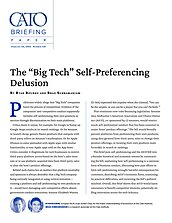1. Elizabeth Warren, (@ewarren), “You can be the umpire, or you can be a player, but you can’t be both at the same time. We need to #BreakUpBigTech so we can level the playing field.” Twitter, December 18, 2020, 4:19 p.m., https://twitter.com/ewarren/status/1340044102386266124?s=20.
2. American Innovation and Choice Online Act, S. 2992, 117th Cong. § 2 (2021), https://www.congress.gov/bill/117th-congress/senate-bill/2992.
3. Adam Kovacevich, “Senator Klobuchar Wants to Ban FaceTime, Amazon Prime, and Google Maps in Search Results,” Chamber of Progress (blog), October 14, 2021; and Adam Kovacevich, “A Closer Look: How Senator Klobuchar’s Bill Would Ban Amazon Prime,” Chamber of Progress (blog), November 2, 2021.
4. American Innovation and Choice Online Act, S. 2992, 117th Cong. § 3(a)1 (amended), https://www.cato.org/sites/cato.org/files/2022–02/AICO%20Amendment%201–19-22%20Unmarked%20copy.pdf.
5. American Innovation and Choice Online Act § 3(b)1 (amended).
6. American Innovation and Choice Online Act § 2(a)8 (amended).
7. American Innovation and Choice Online Act § 2(a)5 (amended).
8. “2020 Amazon Annual Report,” Amazon, 2021, https://www.annualreports.com/HostedData/AnnualReports/PDF/NASDAQ_AMZN_2020.pdf.
9. Ramsi Woodcock, “To Produce Is to Self-Preference,” What Am I Missing? (blog), November 19, 2021, https://zephyranth.pw/2021/11/19/the-buy-or-make-or-market-decision/.
10. “PLMA’s 2021 Private Label Yearbook: A Statistical Guide to Today’s Store Brands,” Private Label Manufacturers Association, 2021, https://plma.com/sites/default/files/files/2021–05/plma2021yearbook2.pdf.
11. Tanay Jaipuria, “Private Labels and Antitrust,” Tanay’s Newsletter (blog), June 14, 2021.
12. See Brown Shoe Co. Inc. v. United States, 370 U.S. 294 (1962); and Fortner Enterprises Inc. v. United States Steel Corp., 394 U.S. 495 (1969).
13. Aurelien Portuese, “Principles of Dynamic Antitrust: Competing through Innovation,” Information Technology and Innovation Foundation, June 14, 2021.
14. See “13. Purchasing Firm’s Market” and “16. Economies” in “II. Vertical Mergers,” 1968 Merger Guidelines, U.S. Department of Justice Archives, https://www.justice.gov/archives/atr/1968-merger-guidelines.
15. D. Daniel Sokol,” The Transformation of Vertical Restraints: Per Se Illegality, the Rule of Reason, and Per Se Legality,” Antitrust Law Journal 79, no. 3 (2014): 1003–16.
16. Roy W. Kenney and Benjamin Klein, “The Economics of Block Booking,” Journal of Law and Economics 26, no. 3 (October 1983): 497–540.
17. See “3.5 Efficiencies” and “4.24 Efficiencies” in “1. Purpose and Underlying Policy Assumptions,” 1984 Merger Guidelines, U.S. Department of Justice Archives, https://www.justice.gov/archives/atr/1984-merger-guidelines.
18. The following reflects the change in sentiment: Jefferson Parish Hosp. Dist. v. Hyde, 466 U.S. 2 (1984); and Francine Lafontaine and Margaret Slade, “Exclusive Contracts and Vertical Restraints: Empirical Evidence and Public Policy,” Journal of Economic Literature 43, no. 3 (September 2005): 762–800.
19. Ali Hortaçsu and Chad Syverson, “Cementing Relationships: Vertical Integration, Foreclosure, Productivity, and Prices,” Journal of Political Economy 115, no. 2 (April 2007): 250–301; and John Asker, “Diagnosing Foreclosure due to Exclusive Dealing,” Journal of Industrial Economics 64, no. 3 (September 2016): 375–410.
20. Jens Foerderer et al., “Does Platform Owner’s Entry Crowd Out Innovation? Evidence from Google Photos,” Information Systems Research 29, no. 2 (June 2018): 444–60.
21. Daniel P. O’Brien, “The Pros and Cons of Vertical Restraints,” Konkurrensverket Swedish Competition Authority, 2008.
22. Francine Lafontaine and Margaret Slade, “Vertical Integration and Firm Boundaries: The Evidence,” Journal of Economic Literature 45, no. 3 (September 2007): 629–85, tables 16 and 17.
23. James C. Cooper et al., “Vertical Antitrust Policy as a Problem of Inference,” Federal Trade Commission, February 18, 2005.
24. “Vertical Merger Guidelines,” U.S. Department of Justice and Federal Trade Commission, June 30, 2020; and “Federal Trade Commission Withdraws Vertical Merger Guidelines and Commentary,” Federal Trade Commission, September 15, 2021.
25. Benedict Evans, “Platforms, Bundling and Kill Zones,” Benedict Evans (blog), December 21, 2020.
26. Woodcock, “To Produce Is to Self-Preference.”
27. Sam Bowman, “Digital Platforms Aren’t Utilities—Treating Them Like They Are Won’t Help,” The Hill, October 16, 2020.
28. Benedict Evans, “Shopify,” Benedict Evans (blog), February 17, 2021.
29. Lucas Shaw, “Netflix Is Losing Market Share. But Is It Losing Customers?,” Bloomberg, April 18, 2021.
30. Nihal Krishan, “Antitrust Bill Would Destroy Amazon Prime, Critics Say,” Washington Examiner, January 14, 2022.
31. American Innovation and Choice Online Act § 3(c)7(v)II (amended).
32. American Innovation and Choice Online Act § 3(b)1 (amended).
33. American Innovation and Choice Online Act § 3(a)5 (amended).
34. American Innovation and Choice Online Act § 3(a)1 (amended).
35. American Innovation and Choice Online Act § 3(a) (amended).
36. “Preponderance of the Evidence,” Legal Information Institute, Cornell Law School, https://www.law.cornell.edu/wex/preponderance_of_the_evidence.
37. “Clear and Convincing Evidence,” Legal Information Institute, Cornell Law School, https://www.law.cornell.edu/wex/clear_and_convincing_evidence.
38. Timothy P. Carney, “Senators from Walmart and Target Country Craft Anti-Amazon Bill,” Washington Examiner, November 9, 2021, https://www.washingtonexaminer.com/opinion/senators-from-walmart-and-target-country-craft-anti-amazon-bill.


